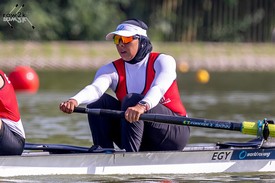Our brains and muscles are 75% water. Keeping properly hydrated is the key to peak performance, as well as being a safety matter. The more fully saturated muscle tissue is, the greater its contractive strength. Keeping muscles saturated allows them to burn energy more efficiently, regulate body temperature better, and to wash away the byproducts of exertion (lactic acid, ammonia, and other toxins), thus boosting endurance. Wash the impurities out of your body ("Pee clear!"). Proper hydration also improves breathing by moistening the entire respiratory tract as well as the incoming air.
In other words, dihydrogen monoxide is high-energy fuel for your boat. Water naturally boosts our metabolisms. (Lightweight rowers who make weight by dehydrating themselves are drastically impairing their performance. More about lightweight nutrition -- or the absence thereof -- in a future column.)
Some numbers. Rowers may need/want much more; these are guidelines only:
| DAILY CONSUMPTION | |||
|---|---|---|---|
| Body Wt. (in lbs.) | Light Activity | Moderate Activity | Strenuous Activity |
| 115 | 72 oz. | 76 oz. | 80 oz. |
| 125 | 72 oz. | 80 oz. | 88 oz. |
| 150 | 72 oz. | 80 oz. | 92 oz. |
| 175 | 76 oz. | 84 oz. | 100 oz. |
| 200 | 76 oz. | 88 oz. | 106 oz. |
| Source: Felicia Busch, M.P.H., R.D. | |||
Note that the daily water requirement becomes proportionally much higher per body weight as the activity increases. Adjusting for the eight hours spent sleeping, this means that a moderately active 175 lb. rower should drink at least 6.5 oz. of water per (non-workout) hour. During a workout, rowers should replenish water at the rate of 4-6 oz. every 15-20 minutes. If your rowers are properly hydrating, the coxswain should find an empty, or nearly empty, 24-oz water bottle under each of the seats after the boat docks.
Constantly sipping is better than bolting large amounts three or four times per day. We transpire water even while we are sleeping (about a quart during a normal night's sleep), so rehydrating ourselves first thing in the morning is very important -- you don't want to begin your day down a quart. When on the water, take advantage of every pause in practice to remind your rowers to drink. Carry extra water bottles aboard with you to distribute to your crew. The U.S. Army, when on hot-weather maneuvers, holds its officers responsible for seeing that every soldier drinks a pint of water every half hour, and woe betide any lieutenant if anyone in the platoon should pass out or suffer from heat.
Water absorbed with food is even more helpful than water drunk directly because it carries nutrients into our bloodstream with it. Eating high water-content foods reduces the amount of blood our bodies need to divert to the digestive tract. Cantaloupe and other melons are the highest in water content, with other fruits such as oranges and grapefruits, and bananas, nearly as good. The potassium they contain is excellent for adjusting the body's metabolism to the demands of hot weather. Pasta is a superb carbohydrate for hot (and all) weather because it contains a fair amount of water. Least helpful are meats, both because they are drier, and because proteins require relatively high amounts of water to digest. Caffeinated drinks (soda, coffee, tea) actually dehydrate you because caffeine (C8H10N4O2, trimethylxanthine) is a diuretic. This is fine for washing out your system, but it means a net loss in fluids, so avoid those beverages when you are training, or else drink an equal amount of water for every can of soda you drink.
Do not rely on thirst to tell you when to drink; the thirst response kicks in after you have already begun to get dehydrated. Don't get caught behind the curve and have to work your way out again.
The days leading up to the race (with two days prior being the most important) is the key time to be super hydrated. Encourage your rowers to drink all the water they comfortably can during this period. They can taper off a little bit on race day itself if they are worried about having too much sloshing around in their stomachs.
A quick external indicator which coxswains can monitor to make sure that rowers are getting enough water is to look at their lower lips -- they should be smooth and full, with few or no cracks or lines in them. This is also a good indicator of whether they are getting enough vitamin C.
Symptoms of dehydration (e.g. loss of muscle tone, decreased body temperature regulation, dry skin, lower metabolism, slowed reactions, and decreased alertness) are remarkably similar to the symptoms of aging. There is growing evidence that the fountain of youth might be just that, the water fountain.
If you enjoy and rely on row2k, we need your help to be able to keep doing all this. Though row2k sometimes looks like a big, outside-funded operation, it mainly runs on enthusiasm and grit. Help us keep it coming, thank you! Learn more.
- Bont Rowing
- Calm Waters Rowing
- Concept 2
- Craftsbury Sculling
- The Crew Classic
- CrewLAB
- Croker
- Durham Boat Co.
- Empacher
- Faster Masters
- Filippi
- Fluidesign
- h2row.net
- HUDSON
- Live2Row Studios
- Nielsen-Kellerman
- Oak Ridge RA
- Peinert Boat Works
- Pocock Racing Shells
- Race1 USA
- RowKraft
- Rubini Jewelers
- Vespoli USA
- WinTech Racing
- Bont Rowing
- Calm Waters Rowing
- Concept 2
- Craftsbury Sculling
- The Crew Classic
- CrewLAB
- Croker
- Durham Boat Co.
- Empacher
- Faster Masters
- Filippi
- Fluidesign
- h2row.net
- HUDSON
- Live2Row Studios
- Nielsen-Kellerman
- Oak Ridge RA
- Peinert Boat Works
- Pocock Racing Shells
- Race1 USA
- RowKraft
- Rubini Jewelers
- Vespoli USA
- WinTech Racing

















